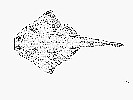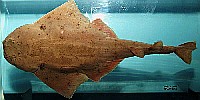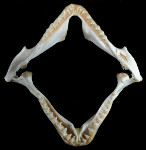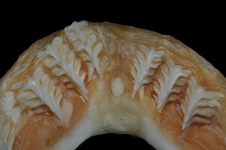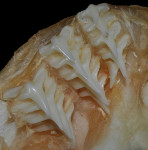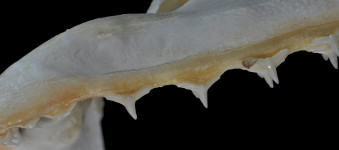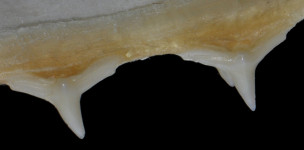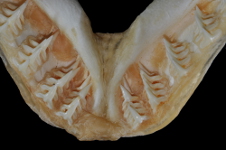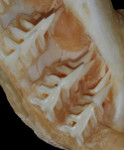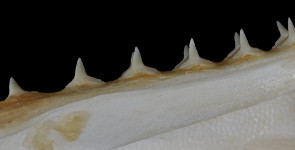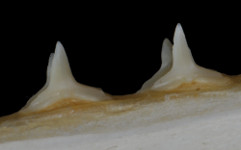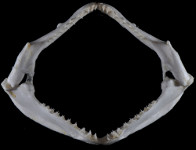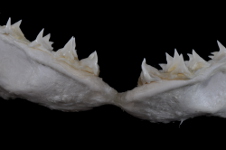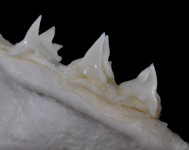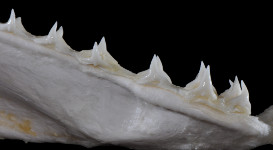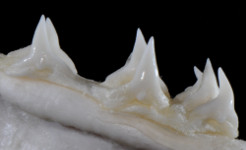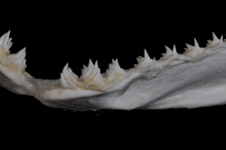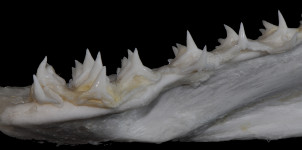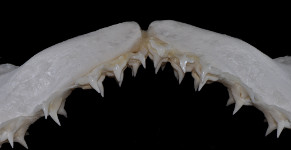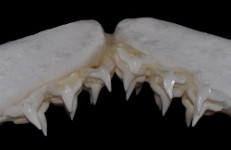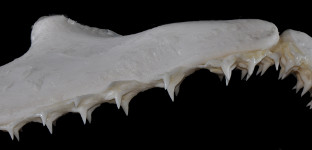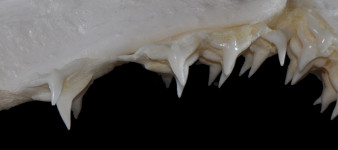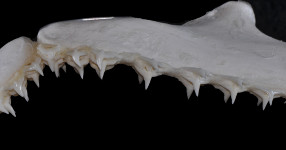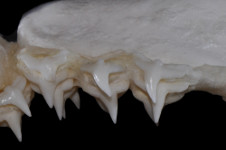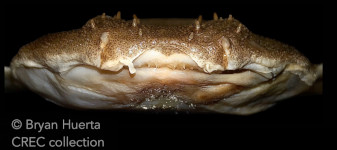Squatina dumeril
Lesueur, 1818
Sand devil
Classification: Elasmobranchii Squatiniformes Squatinidae
Reference of the original description
Description of several new species of North American fishes. Journal of the Academy of Natural Sciences of Philadelphia, 1(ser. 1), 222–235
Description of several new species of North American fishes. Journal of the Academy of Natural Sciences of Philadelphia, 1(ser. 1), 222–235
Image of the original description
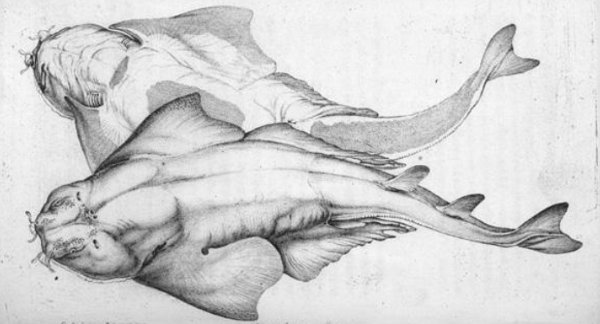
Squatina dumeril Lesueur, 1818

Squatina dumeril Lesueur, 1818
Synonyms / new combinations and misspellings
Rhina dumeril, Rhina dumerili, Rhina dumerilii, Squatina aff. dumerili, Squatina cf. dumeril, Squatina dumeriil, Squatina dumerili
Rhina dumeril, Rhina dumerili, Rhina dumerilii, Squatina aff. dumerili, Squatina cf. dumeril, Squatina dumeriil, Squatina dumerili
Description :
Citation: Squatina dumeril Lesueur, 1818: In: Database of modern sharks, rays and chimaeras, www.shark-references.com, World Wide Web electronic publication, Version 05/2025
Please send your images of "Squatina dumeril" to info@shark-references.com
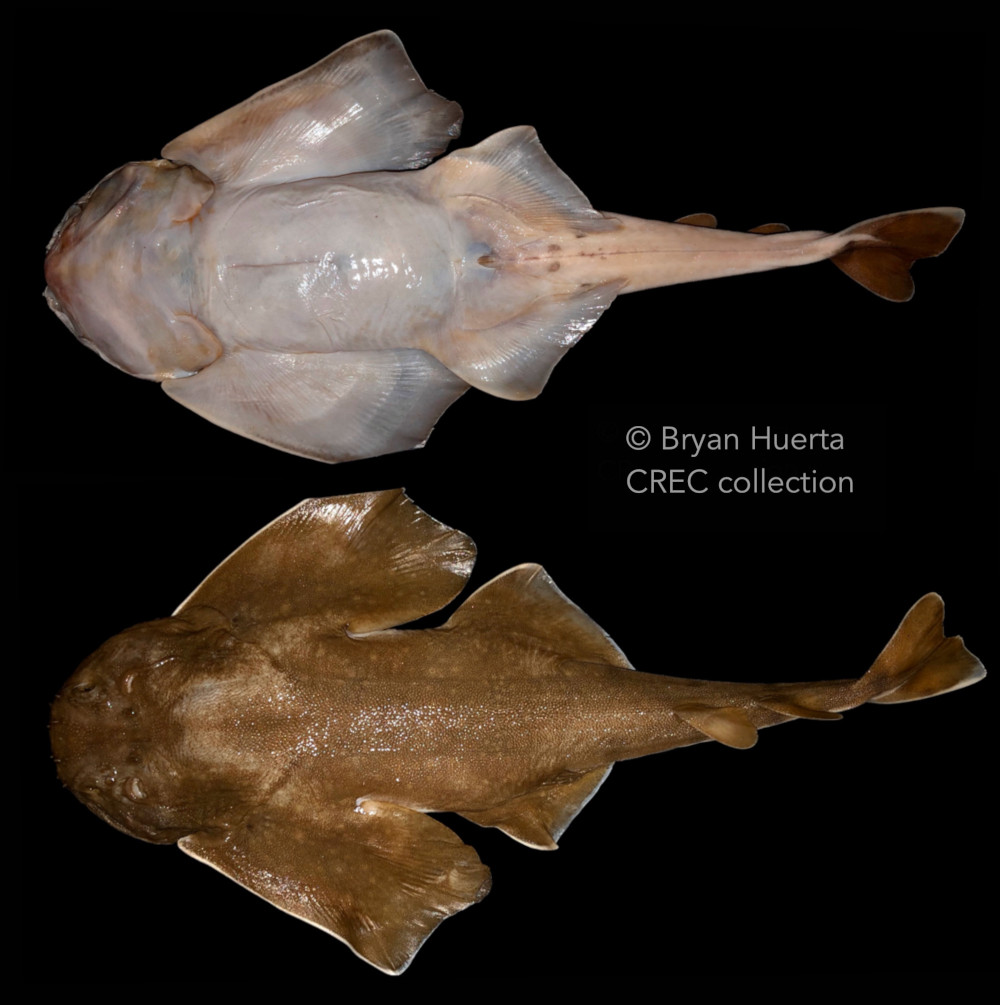
Squatina dumeril Lesueur, 1818, female, 226mm TL, 132 total vertebral count, dental formula: (9-9/10-10), northern Gulf of Mexico, Mississippi State University Coastal Research and Extension Center © Bryan Huerta

Squatina dumeril Lesueur, 1818, female, 226mm TL, 132 total vertebral count, dental formula: (9-9/10-10), northern Gulf of Mexico, Mississippi State University Coastal Research and Extension Center © Bryan Huerta
Common names
 Angelote del Atlántico,
Angelote del Atlántico,  Tiburón,
Tiburón,  Tiburón ángel,
Tiburón ángel,  Ange de l"Atlantique,
Ange de l"Atlantique,  Ange de mer de sable,
Ange de mer de sable,  Angel shark,
Angel shark,  Atlantic angel shark,
Atlantic angel shark,  Monkfish,
Monkfish,  Sand devil
Sand devil
 Angelote del Atlántico,
Angelote del Atlántico,  Tiburón,
Tiburón,  Tiburón ángel,
Tiburón ángel,  Ange de l"Atlantique,
Ange de l"Atlantique,  Ange de mer de sable,
Ange de mer de sable,  Angel shark,
Angel shark,  Atlantic angel shark,
Atlantic angel shark,  Monkfish,
Monkfish,  Sand devil
Sand devil
Short Description
Field marks and Diagnostic Features after EBERT & STEHMANN, 2013 [17836]: An angel shark with simple, tapering nasal barbels and weakly fringed or smooth anterior nasal flaps, lateral head folds without triangular lobes, large eyes with eye–spiracle space less than 1.5 times eye length, fairly broad and posteriorly angular pectoral fins without an anterior shoulder, rough, hooked dorsal denticles, and nearly plain dorsal coloration without elaborate spotting or ocelli on body. Diagnostic Features: Interorbital space strongly concave. Head width about 3.1 in precaudal length. Head length to notch about 4.0 in precaudal length and 1.4 in head width. Lateral head folds low, without triangular lobes. Eye length 4.1 in interorbital space; preorbital length greater than eye length; eye–spiracle space less than 1.5 times eye length. Spiracle width greater than eye length; spiracles with 10 pseudobranchial folds; interspiracular space slightly greater (about 1.1 times) than interorbital space. Nasal barbels with simple tapering tips; posterior edges of anterior nasal flaps low and weakly fringed; tips of anterior nasal flaps narrow and hardly fringed, not strongly lobate; posterior nasal flaps moderately enlarged, not fringed. Nostril width about 4.5 in internarial width. Exposed upper lip between bases of anterior nasal flaps forming a low, broad, rounded arch. Tooth row counts 38 upper jaw, 40 lower jaw. Body width at pectoral–fin insertions about 0.9 times head length to upper notch and 4.4 in precaudal tail. Tail length from pelvic–fin insertions to upper caudal– fin origin 1.1 to 1.2 times trunk length from pectoral–fin origins to pelvic–fin insertions. Small but prominent thorns present on snout, interorbital space, and with a few between spiracles, fewer and more discrete in young but more numerous and forming patches in adults; small but prominent thorns present on midline of back in front of first dorsal fin, between dorsal fins, and on postdorsal space in young, but adults have these reduced and inconspicuous. Dorsal denticles loosely spaced, surface slightly rough; denticles fairly sharp–cusped, broadly hooked, and with 4 or more anterior ridges. Adult males with enlarged thorns on anterior margins and apices of pectoral fins. Underside of body naked except for anterior margins of pectoral and pelvic fins, ventral surface of tail, and scattered patches on the abdomen and fin bases. Angle of pectoral– fin apex narrowly obtuse, slightly greater than a right angle. Pectoral–fin anterior margins straight, not forming a distinct anterior shoulder, apices narrowly rounded, posterior margin slightly concave, rear tips narrowly rounded or subangular, inner margins broadly convex and rounded. Distance from anterior tip of pectoral fin to insertion about 0.6 of maximum pectoral–fin length from anterior tip to free rear tip; maximum pectoral–fin length about 39% of maximum total length to tip of lower caudal–fin lobe. Free rear tip of pectoral fin closer to pelvic–fin apex than pelvic–fin origin. First dorsal–fin origin posterior to pelvic–fin free rear tips by about half interorbital. First dorsal–fin base about 2 in interdorsal space, 2.0 to 2.1 times in postdorsal space. Postventral caudal–fin margin nearly vertical and truncate, or diagonal. Vertebral counts: total vertebral counts 132 to 137, total precaudal counts 101 to 107, monospondylous vertebral counts 45 to 48, diplospondylous precaudal counts 55 to 59. A large sized angel shark, possibly reaching a maximum total length of 152 cm. Colour: bluish grey or ashy grey dorsally when fresh, chocolate brown in preservative, underside white with red spots on throat, abdomen, and on tail behind the vent; pectoral and pelvic fins with reddish ventral margins; faint symmetrical white spotting on dorsal surface in young but not adults; no discrete darker spotting on dorsal surface; no ocelli on back; pectoral and pelvic–fin webs with pale reddish brown anterior and posterior margins; dorsal–fin webs darker and bases and rear tips light, unspotted; caudal fin with light base and darker web, without numerous dark or pale spots.
Field marks and Diagnostic Features after EBERT & STEHMANN, 2013 [17836]: An angel shark with simple, tapering nasal barbels and weakly fringed or smooth anterior nasal flaps, lateral head folds without triangular lobes, large eyes with eye–spiracle space less than 1.5 times eye length, fairly broad and posteriorly angular pectoral fins without an anterior shoulder, rough, hooked dorsal denticles, and nearly plain dorsal coloration without elaborate spotting or ocelli on body. Diagnostic Features: Interorbital space strongly concave. Head width about 3.1 in precaudal length. Head length to notch about 4.0 in precaudal length and 1.4 in head width. Lateral head folds low, without triangular lobes. Eye length 4.1 in interorbital space; preorbital length greater than eye length; eye–spiracle space less than 1.5 times eye length. Spiracle width greater than eye length; spiracles with 10 pseudobranchial folds; interspiracular space slightly greater (about 1.1 times) than interorbital space. Nasal barbels with simple tapering tips; posterior edges of anterior nasal flaps low and weakly fringed; tips of anterior nasal flaps narrow and hardly fringed, not strongly lobate; posterior nasal flaps moderately enlarged, not fringed. Nostril width about 4.5 in internarial width. Exposed upper lip between bases of anterior nasal flaps forming a low, broad, rounded arch. Tooth row counts 38 upper jaw, 40 lower jaw. Body width at pectoral–fin insertions about 0.9 times head length to upper notch and 4.4 in precaudal tail. Tail length from pelvic–fin insertions to upper caudal– fin origin 1.1 to 1.2 times trunk length from pectoral–fin origins to pelvic–fin insertions. Small but prominent thorns present on snout, interorbital space, and with a few between spiracles, fewer and more discrete in young but more numerous and forming patches in adults; small but prominent thorns present on midline of back in front of first dorsal fin, between dorsal fins, and on postdorsal space in young, but adults have these reduced and inconspicuous. Dorsal denticles loosely spaced, surface slightly rough; denticles fairly sharp–cusped, broadly hooked, and with 4 or more anterior ridges. Adult males with enlarged thorns on anterior margins and apices of pectoral fins. Underside of body naked except for anterior margins of pectoral and pelvic fins, ventral surface of tail, and scattered patches on the abdomen and fin bases. Angle of pectoral– fin apex narrowly obtuse, slightly greater than a right angle. Pectoral–fin anterior margins straight, not forming a distinct anterior shoulder, apices narrowly rounded, posterior margin slightly concave, rear tips narrowly rounded or subangular, inner margins broadly convex and rounded. Distance from anterior tip of pectoral fin to insertion about 0.6 of maximum pectoral–fin length from anterior tip to free rear tip; maximum pectoral–fin length about 39% of maximum total length to tip of lower caudal–fin lobe. Free rear tip of pectoral fin closer to pelvic–fin apex than pelvic–fin origin. First dorsal–fin origin posterior to pelvic–fin free rear tips by about half interorbital. First dorsal–fin base about 2 in interdorsal space, 2.0 to 2.1 times in postdorsal space. Postventral caudal–fin margin nearly vertical and truncate, or diagonal. Vertebral counts: total vertebral counts 132 to 137, total precaudal counts 101 to 107, monospondylous vertebral counts 45 to 48, diplospondylous precaudal counts 55 to 59. A large sized angel shark, possibly reaching a maximum total length of 152 cm. Colour: bluish grey or ashy grey dorsally when fresh, chocolate brown in preservative, underside white with red spots on throat, abdomen, and on tail behind the vent; pectoral and pelvic fins with reddish ventral margins; faint symmetrical white spotting on dorsal surface in young but not adults; no discrete darker spotting on dorsal surface; no ocelli on back; pectoral and pelvic–fin webs with pale reddish brown anterior and posterior margins; dorsal–fin webs darker and bases and rear tips light, unspotted; caudal fin with light base and darker web, without numerous dark or pale spots.
Distribution
Western Atlantic: southern New England, USA to the Gulf of Mexico, Jamaica and Venezuela. Also in Columbia [17659]. Source: www.gbif.org
Western Atlantic: southern New England, USA to the Gulf of Mexico, Jamaica and Venezuela. Also in Columbia [17659]. Source: www.gbif.org
Human uses
fisheries: minor commercial; price category: medium; price reliability: very questionable: based on ex-vessel price for species in this family
fisheries: minor commercial; price category: medium; price reliability: very questionable: based on ex-vessel price for species in this family
Biology
Ovoviviparous, embryos feed solely on yolk [733]. Occurs on the outer continental shelf and the upper slope. Feeds on small bottom fishes, crustaceans and bivalves.
Ovoviviparous, embryos feed solely on yolk [733]. Occurs on the outer continental shelf and the upper slope. Feeds on small bottom fishes, crustaceans and bivalves.
Remarks
shark-references Species-ID=6913;
shark-references Species-ID=6913;
Parasites (arranged by Jürgen Pollerspöck)
Copepoda
Isopoda
Copepoda
- Eudactylina spinula Pearse, 1950 [16561]
Isopoda








